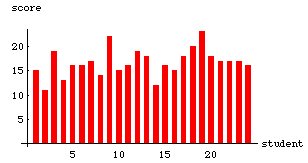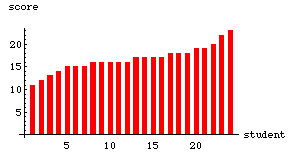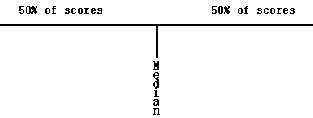
Let's look at the dice game again. Pool all of the scores in the class and then put them in order (lowest to highest or highest to lowest, it doesn't matter). Here is a sample set of scores (you may download this set of scores as a spreadsheet if you have access to Excel):
15, 11, 19, 13, 16, 16, 17, 14, 22, 15, 16, 19, 18, 12, 16, 15, 18, 20, 23, 18, 17, 17, 17, 16

In this example, the class size is 24. Thus, because we have an even number of scores, the median will fall halfway between the two middle (12th and 13th) scores of the ordered set:
11, 12, 13, 14, 15, 15, 15, 16, 16, 16, 16, 16, 17, 17, 17, 17, 18, 18, 18, 19, 19, 22, 20, 23

 In our example, the 12th and l3th scores are 16 and 17, respectively. Now a simple calculation will find the median.
In our example, the 12th and l3th scores are 16 and 17, respectively. Now a simple calculation will find the median.
Median = (16 + 17)/2 = 16.5
Piece of cake, right? Now we can tell if a particular score is in the upper or lower half of the class. You can also decide how well you did compared to everyone else.
In a set of scores, the median is right smack-dab in the middle. Half of the scores are on the left and half on the right, but it doesn't matter how far away from the middle the scores on the sides are. Only the number of scores matters, not the values of the scores. Each score has equal weight (sounds kind of democratic.... "All scores are created equal").

Please continue on to learn about the mean. If you have already studied the mean, you may go directly to central tendency. Do not pass GO. Do not collect $200.
send comments and questions to Jay Hill